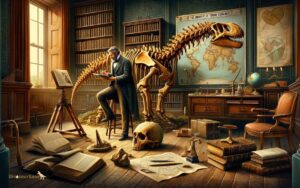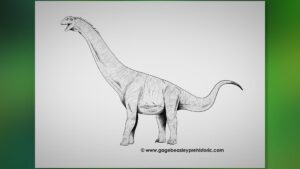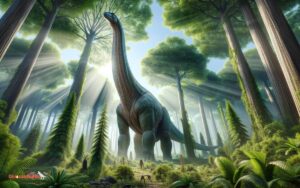What Dinosaur Looks Like a Rhino? Triceratops!
In exploring the rich tapestry of prehistoric life, one cannot overlook the Triceratops, a dinosaur that bears a striking resemblance to modern rhinoceroses.
This creature, distinguished by its formidable frill and trio of facial horns, prompts an intriguing comparison with today’s rhinos, particularly in terms of physical characteristics and ecological niches.
While the superficial similarities are evident, a deeper exploration into the Triceratops’ habitat, lifestyle, and the evolutionary significance of its horns reveals a complex story of adaptation and survival.
The ensuing discussion aims to dissect these parallels and differences, shedding light on how this ancient behemoth navigated its world and what it might tell us about the mechanisms of evolution and adaptation.


Key Takeaway
Unveiling the Triceratops
Among the most iconic and well-studied dinosaurs, the Triceratops stands out for its distinctive physical characteristics and significant contributions to our understanding of Late Cretaceous terrestrial ecosystems.
This herbivorous genus, flourishing approximately 68 to 66 million years ago, marks a pivotal point in paleontological research, providing insights into the dynamics of prehistoric flora and fauna interactions.
Through the examination of fossilized remains, scientists have been able to reconstruct aspects of its habitat, diet, and potential predators, shedding light on the evolutionary pressures that shaped its development.
Furthermore, the Triceratops plays a crucial role in debates concerning dinosaur social behavior and ontogeny, offering a window into the complex ecological web of its time.
Its study exemplifies the interconnectedness of species within ancient ecosystems, underlining the importance of paleontological research in understanding Earth’s biological history.
Physical Characteristics
Building on our understanding of the Triceratops’ ecological role, an examination of its physical characteristics reveals a creature remarkably adapted for survival in the Late Cretaceous period.
The Triceratops, akin to modern rhinoceros in some aspects, diverges significantly in its unique adaptations.
- Massive Skull with a Frill: Providing defense against predators and possibly used in mating displays.
- Three Prominent Horns: Evoking a sense of awe, these could intimidate rivals or predators.
- Robust Body Structure: Designed for strength and endurance, reflecting a life of constant vigilance.
- Herbivorous Dentition: Specialized teeth for processing tough plant material, highlighting the dinosaur’s role in its ecosystem.
Analyzing these characteristics, it becomes evident that the Triceratops was a formidable presence in its environment, embodying resilience and majesty.
Comparison With Modern Rhinos
In examining the dinosaur that exhibits similarities to modern rhinoceroses, a detailed comparison of physical traits reveals significant insights into evolutionary pathways and morphological adaptations.
The contrast in habitat and behavior between this prehistoric creature and contemporary rhinos further enriches our understanding of ecological niches and survival strategies over millions of years.
This analysis not only highlights the divergences and convergences in the evolutionary trajectory but also sheds light on the intricate relationship between organisms and their environments through geological time scales.
Physical Traits Comparison
While the newly discovered dinosaur shares a superficial resemblance to modern rhinos, a detailed comparison of their physical traits reveals significant evolutionary divergences.
These distinctions not only highlight the vast timeline separating their existences but also underscore the remarkable adaptability and diversity of life on Earth.
Consider the following contrasts:
- The dinosaur’s skin, presumed to be more scaly and less keratinous than the thick, protective hide of rhinos.
- A more pronounced horn structure, potentially used for defense or mating rituals, vastly differing in shape and function.
- The limb structure suggests a different mode of locomotion, indicative of varying habitat preferences and lifestyle.
- Dental analysis reveals a distinct diet, pointing to fundamental ecological niches occupied by these creatures.
These comparisons not only enlighten us about the past but also deepen our appreciation for the complexity of evolution.
Habitat and Behavior Contrast
Exploring the habitats and behaviors of the newly discovered dinosaur in comparison to modern rhinos reveals profound differences that shed light on their respective evolutionary paths.
These insights are critical for understanding the ecological niches they occupied and how their environments shaped their development over millions of years.
| Aspect | Newly Discovered Dinosaur | Modern Rhino |
|---|---|---|
| Habitat | Predominantly forested areas with abundant vegetation | Savannas, grasslands, and dense forests in Africa and Asia |
| Social Behavior | Solitary or in small groups, territorial | Generally solitary, but also found in small groups; less territorial |
| Diet | Herbivorous, with a preference for specific plants | Herbivorous, with a broader diet including grass, leaves, and shoots |
This comparison indicates not only environmental adaptations but also divergent social structures, which have significant implications for their survival and reproduction strategies.
Habitat and Lifestyle
The habitat and lifestyle of the dinosaur resembling a rhino reveal significant insights into its ecological niche and survival strategies.
Analyzing the ancient environments in which these creatures thrived allows for a deeper understanding of their daily behaviors and interactions within their ecosystems.
Ancient Environments
Understanding the ancient environments in which dinosaurs resembling rhinoceroses lived requires a detailed examination of the fossil record, indicating a diverse range of habitats from lush forests to arid deserts that these massive creatures once roamed.
This diversity reflects the adaptability and ecological roles these dinosaurs played, from browsers of low-lying vegetation in dense woodland areas to foragers in open, sandy plains.
- Lush, verdant forests teeming with life, offering shelter and abundant food sources.
- Wide, open plains where the sound of massive herds thundered across the landscape.
- Arid deserts, challenging the survival skills of these great beasts with extreme conditions.
- Dense, swampy wetlands, rich in plant life and teeming with both competition and predators.
This spectrum of habitats showcases the complexity of ecosystems that supported these ancient giants, highlighting their remarkable adaptability and the rich tapestry of life that flourished during their era.
Daily Behaviors
Building on the knowledge of the diverse habitats these dinosaur species inhabited, examining their daily behaviors offers insights into how they adapted their lifestyle to thrive in such varied environments.
These rhino-like dinosaurs, primarily herbivores, likely engaged in extensive foraging activities to meet their substantial nutritional needs.
Their physical adaptations, such as strong limbs and, in some cases, beak-like mouths, suggest a lifestyle centered around grazing or browsing on high-fiber vegetation. This indicates a significant amount of their daily routine was dedicated to locating and consuming food sources.
Furthermore, their social behavior, inferred from fossil evidence of herd-like formations, points towards complex social structures and interactions.
Such behaviors would have been crucial for their survival, aiding in protection against predators, finding resources, and nurturing their young.
The Horns: Form and Function
Several species of dinosaurs that resembled rhinoceroses possessed horns, which served a dual purpose of defense against predators and as a display mechanism for attracting mates or asserting dominance within their social groups.
These horns, often constructed from keratin or bone, varied significantly in size, shape, and number across different species. Their form and function highlight the complex interplay between an organism’s physical attributes and its ecological and social environments.
- The sight of a Triceratops defending its young with formidable brow horns evokes a powerful sense of primordial guardianship.
- Ceratopsians flaunting their elaborate horn arrangements stir images of ancient rituals of courtship and competition.
- The strategic use of horns in combat against predators ignites admiration for the prehistoric survival instinct.
- Observing the intricate horn structures prompts a profound respect for evolutionary craftsmanship.
Evolutionary Insights
Exploring the intricate design of horns among ceratopsian dinosaurs offers valuable evolutionary insights into how these physical features adapted over time to meet ecological demands and social pressures.
These dinosaurs, reminiscent of modern rhinos in their robust form and prominent horns, showcase a remarkable example of evolutionary innovation.
The variation in horn shape and size among ceratopsians is indicative of a dynamic evolutionary trajectory, driven by the dual pressures of predator defense and intraspecies competition.
Scientific analysis suggests that the evolutionary modification of these horns was likely a response to changing environments and the need for social hierarchy within herds.
This adaptation not only highlights the evolutionary plasticity within the ceratopsian lineage but also underscores the complex interplay between form, function, and survival in the evolutionary narrative of dinosaurs.
Discoveries and Fossils
Recent fossil discoveries have unveiled a plethora of ceratopsian species, shedding light on their diverse morphologies and enriching our understanding of their evolutionary history.
These ceratopsians, often likened to the modern rhinoceros due to their impressive horned faces, have been pivotal in piecing together the ecological dynamics of the Late Cretaceous period.
The unearthed fossils depict a wide range of horn configurations, suggesting a complex social or ecological function.
Skull fragments reveal intricate sinus structures, indicative of potential communication mechanisms.
Isotopic analysis of bone samples offers insights into the dietary preferences across different ceratopsian species.
The discovery of juvenile specimens provides rare glimpses into the growth patterns and developmental stages of these ancient creatures.
These findings not only captivate the imagination but also underscore the scientific importance of paleontological research in unraveling Earth’s prehistoric past.
Triceratops in Popular Culture
The Triceratops, with its distinctive three-horned face, has become an iconic figure in popular culture, frequently appearing in literature, film, and other media as a symbol of prehistoric life.
Its representation ranges from scientifically accurate depictions to more fantastical interpretations, reflecting both our evolving understanding and our enduring fascination with this ancient creature.
To illustrate the Triceratops’ impact on popular culture, consider the following table:
| Medium | Example |
|---|---|
| Film | “Jurassic Park” series |
| Literature | “The Lost World” by Arthur Conan Doyle |
| Television | “Dinosaurs” (TV series) |
| Video Games | “ARK: Survival Evolved” |
| Toys | LEGO Dinosaur sets |
This table underscores the versatile presence of Triceratops in various forms of entertainment, highlighting its status as a cultural touchstone in discussions about dinosaurs and prehistoric life.
FAQ About What Dinosaur Looks Like a Rhino
How Did the Diet of the Triceratops Compare to That of Modern Rhinos, Considering Their Different Habitats?
The comparison between the diet of Triceratops and modern rhinos involves analyzing their consumption patterns within their respective habitats, examining plant types consumed and foraging behaviors, despite their existence in vastly different geological epochs and environments.
Were There Any Dinosaurs That Coexisted With the Triceratops Which Might Have Been Its Predators or Competitors for Resources?
Among dinosaurs coexisting with Triceratops, Tyrannosaurus rex was a notable predator, posing significant threats. Additionally, other herbivores competed for resources, but specific interspecies dynamics remain a subject of ongoing scientific investigation and debate within the paleontological community.
Aside From the Triceratops, Were There Any Other Dinosaurs With Similar Physical Attributes That Might Have Been Mistaken for a Rhino-Like Dinosaur by Early Paleontologists?
In addressing the query, it’s pertinent to note that Styracosaurus, another ceratopsian, shares notable rhinoceros-like features, including a prominent nose horn and a frilled neck shield, potentially leading to early misidentification by paleontologists.
How Do Scientists Determine the Color and Texture of the Skin of Triceratops, Given That Their Fossils Do Not Preserve These Soft Tissues?
Scientists infer the color and texture of Triceratops’ skin through comparative analysis of preserved skin impressions, phylogenetic bracketing with modern relatives, and examination of melanosomes in exceptionally well-preserved fossils, despite the lack of direct tissue preservation.
In Terms of Social Behavior, Is There Any Evidence to Suggest That Triceratops Lived in Herds or Were They Solitary Creatures, and How Does This Compare to the Social Behavior of Modern Rhinos?
Current research provides limited direct evidence on triceratops’ social behavior, leaving their grouping tendencies speculative. However, comparisons with modern rhinos, which exhibit varied social structures, suggest potential parallels in solitary or herd behaviors among these ancient creatures.
Conclusion
The Triceratops, with its distinctive three-horned face and large bony frill, stands as a testament to the diverse and fascinating world of dinosaurs that once roamed the Earth.
Through meticulous examination of its physical characteristics, habitat, and evolutionary history, researchers have drawn parallels to the modern rhinoceros, albeit with significant differences.
The study of Triceratops fossils has not only shed light on its own species but also on the broader ecological and evolutionary dynamics of the Cretaceous period.
As more discoveries come to light, the Triceratops continues to capture the imagination, proving that old dogs or in this case, dinosaurs can indeed teach us new tricks.





